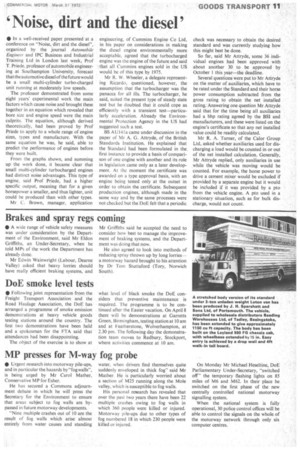'Noise, dirt and the diesel'
Page 13

If you've noticed an error in this article please click here to report it so we can fix it.
• In a well-received paper presented at a conference on "Noise, dirt and the diesel", organized by the journal Automobile Engineer and IPC Business and Industrial Training Ltd in London last week, Prof T. Priede, professor of automobile engineering at Southampton University, forecast that the automotive diesel of t he future would be a small multi-cylinder turbo-charged unit running at moderately low speeds.
The professor demonstrated from some eight years' experimental work the main factors which cause noise and brought these together in an equation which revealed that bore size and engine speed were the main culprits. The equation, although derived theoretically, had been proved by Prof Priede to apply to a whole range of engine sizes, types and manufacture. With the same equation he was, he said, able to predict the performance of engines before they were built.
From the graphs shown, and summing up the work done, it became clear that small multi-cylinder turbocharged engines had distinct noise advantages. This type of engine, said Prof Priede, had a higher specific output, meaning that for a given horsepower a smaller, and thus lighter, unit could he produced than with other types.
Mr C. Brown, manager, application
engineering, of Cummins Engine Co Ltd, in his paper on considerations in making the diesel engine environmentally more acceptable, agreed that the turbocharged engine was the engine of the future and said that all Cummins engines sold in the US would be of this type by 1975.
Mr R. W. Wheeler, a delegate representing Ricardo, questioned, however, the assumption that the turbocharger was the panacea for all ills. The turbocharger, he said, suited the present type of steady state test but he doubted that it could cope as efficiently with a transient test—particularly acceleration. Already the Environmental Protection Agency in the US had suggested such a test.
BS A U141a came under discussion in the paper of Mr A. G. Attryde, of the British Standards Institution. He explained that the Standard had been formulated in the. first instance to provide a basis of comparison of one engine with another and its role in legislation came only as a later development. At the moment the certificate was awarded on a type approval basis, with an engine being tested only at the outset in order to obtain the certificate. Subsequent production engines, although made in the same way and by the same processes were not checked but the DoE felt that a periodic check was necessary to obtain the desired standard and was currently studying how this might best be done.
So far, said Mr Attryde, some 36 individual engines had been approved with about another 30 to be approved by October 1 this year—the deadline.
Several questions were put to Mr Attryde on the matter of auxiliaries, which have to be rated under the Standard and their horse power consumption subtracted from the gross rating to obtain the net installed ratinvAnswering one question Mr Attryde said that for the time being all auxiliaries had a bhp rating agreed by the BSI and manufacturers, and these were listed on the engine's certificate so that any net installed value could be readily calculated.
Mr R. A. Turner, of the Calor Group Ltd, asked whether auxiliaries used for discharging a load would be counted in or out of the net installed calculation. Generally, Mr Attryde replied, only auxiliaries in use while the vehicle was moving would be counted. For example, the horse power to drive a cement mixer would be excluded if provided by a separate engine but it would be included if it was provided by a pto from the vehicle engine. A pto used in a stationary situation, such as for bulk discharge, would not count.




















































































